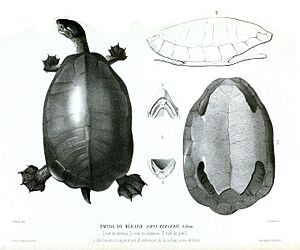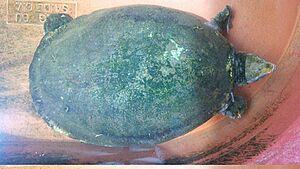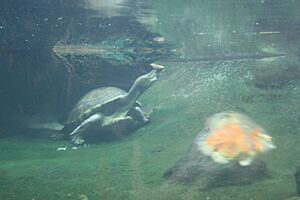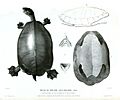Hickatee facts for kids
Quick facts for kids Hickatee |
|
|---|---|
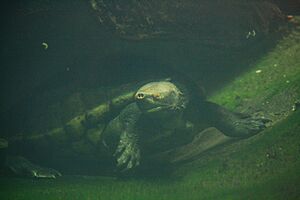 |
|
| In the Prague Zoo | |
| Conservation status | |
| Scientific classification | |
| Genus: |
Dermatemys
|
| Species: |
mawii
|
The hickatee (Dermatemys mawii), also known as the Central American river turtle, is the only living species in its family, Dermatemydidae. In Spanish, it's called tortuga blanca, meaning 'white turtle'.
You can find this turtle in the rivers and lakes of Central America. It lives in Belize, Guatemala, southern Mexico, and possibly Honduras. It's a fairly large turtle. Some have been recorded at 60 cm (24 in) long and weighing 22 kg (49 lb). However, most are smaller.
This turtle eats only plants (it's a herbivore). It lives almost completely in the water. It doesn't even come out to sunbathe! Strangely for a reptile, its eggs can stay alive even after being underwater for weeks. Some scientists used to think it nested underwater, but this was likely because they visited during floods.
The Ancient Mayan people used turtles in many ways. They used them in wars, as musical instruments, and for food. The hickatee was probably eaten by important people during special feasts. The Maya might have even traded these turtles to places where they didn't naturally live. This is based on turtle shell remains found in old cooking sites.
Some evidence suggests that the Mayans and other ancient groups might have hunted the turtle so much that it disappeared from some areas. Today, some turtle populations might have come from turtles moved by people from other places. The turtle also had special meaning in Mayan myths, but much of that is now lost to time. Even today, people in these lands still enjoy eating the turtle during important cultural events. Many say the meat is very tasty. This means the turtle has been used by humans for a very long time.
Because of this long history of use, conservation groups say that hunting the turtle is not sustainable. They have declared the hickatee to be 'critically endangered'. People in Tabasco, Mexico, are often blamed for this. In Belize, it's still legal to hunt these animals. The turtle is common in some remote areas there, but its numbers are low where people live.
In Mexico, the turtle's population status is not clear. Some thought it was almost gone from Mexico in 2006. But many are still caught in places like Tabasco and Quintana Roo. In Guatemala, the species is common in some areas, but rare in others.
Scientists in the 1990s thought breeding these turtles would be too hard. But now we know they can reproduce even in poor water conditions. Since they eat plants, their food costs are low. We have learned a lot about how to care for them. Some US scientists now think that raising them for sale could be profitable. They suggest using special farming systems where turtles are a second source of income. The Mexican government started supporting turtle farming in the 2000s. Now, thousands of hickatees are likely kept in captivity there. However, the health of these captive turtles is not always good, and it's unclear how successful these farms are.
Contents
What is the Central American River Turtle?
The hickatee, Dermatemys mawii, is the only living species in its family, Dermatemydidae. Its closest relatives are only known from fossils. These ancient turtles lived all over the world during the Jurassic and Cretaceous periods.
Why is it called 'white turtle'?
This species is often called tortuga blanca in Spanish. This means 'white turtle'. It's called this because its meat turns white when cooked. Other common turtle meat, like that from the red-eared slider, turns dark when cooked.
How do ancient people affect turtle genes?
Many animals in this region show differences in their genes based on where they live. But a 2011 study of the hickatee's mitochondrial DNA (mtDNA) showed a different pattern. The study found that different groups of turtles had mixed their genes. This suggests that people, especially the Ancient Maya, moved turtles around a lot. This movement might have blurred the natural genetic patterns.
Some populations had very little genetic diversity. This could mean they went through a bottleneck. This happens when a population shrinks a lot, possibly from too much hunting. Then, the population grows again, but with less genetic variety. The Maya likely traded and ate many of these turtles. This could explain why their genes are so mixed up today. Even now, turtles are found in small ponds or places where they don't naturally belong. People likely moved them there to harvest them later.
What does the Hickatee look like?
The hickatee is a large turtle. Some old records show them being 60 cm (24 in) long and weighing 22 kg (49 lb). However, today, most are smaller. In Mexico, few are over 14 kg (31 lb), and in Guatemala, few are over 11 kg (24 lb).
It has a low, flat, smooth shell (carapace). Young turtles have a small ridge down the middle. The shell is usually brown, almost black, gray, or olive. The bottom shell (plastron) is usually white to yellow. It might get stained by the mud where the turtle lives. Young turtles also have bumpy edges on their shells. These features disappear as the turtle gets older. Its skin is mostly the same color as its shell. It has reddish or peach-colored marks around its neck and on its underside.
Adult males often have yellow (sometimes cream or reddish-brown) marks on their heads. Females have plain, dull-colored heads. Males also have longer, thicker tails.
Where does the Central American River Turtle live?
The hickatee lives in large rivers and lakes that flow into the Atlantic Ocean. Its range goes from southern Mexico through Belize to the border of Guatemala and Honduras.
In Mexico, you can find it in the states of Veracruz, Tabasco, Campeche, northern Oaxaca, northern Chiapas, and southern Quintana Roo. It mainly lives in the river systems of the Papaloapan, Coatzacoalcos, and Grijalva-Usumacinta River.
In Guatemala, the species lives in southern and central Petén Department. It also lives south to Lago de Izabal and the rivers that flow into it. In 2011, it was not known if it lived in the Río Motagua near Honduras. It was common in the Pasión River and its branches in 1998. It was once common in Lake Petén Itzá but became rarer by 1998. It is well protected in Yaxhá Lake. In 2007, researchers found it was common in northern Petén, in the Maya Biosphere Reserve. They estimated about 4,081 turtles in that area. This number is likely much lower than the real total, as it only counted large water bodies. Very high numbers of turtles were found in Laguna Peru in 2007 and 2009.
What is the Hickatee's lifestyle?
The hickatee is a night-active turtle. It lives completely in the water. It does not sunbathe or leave the water, except to lay eggs.
What eats the Hickatee?
The main predator of the hickatee is the otter (Lontra longicaudis). Otters can keep turtle populations low by eating young turtles. Some studies show otters eating many turtles in parts of Belize. Otters usually bite off the heads, tails, and limbs of turtles. They might also eat the insides, but they leave the shell whole.
Crocodiles like Crocodylus moreletii and Crocodylus acutus usually eat young turtles or hatchlings. Crocodiles crush the shell and swallow the turtle whole. The indigo snake (Drymarchon melanurus) eats the eggs and hatchlings. Raccoons (Procyon lotor) might eat nesting females. They also eat eggs and hatchlings. Other animals that eat eggs and hatchlings include coati (Nasua narica) and birds. Birds like rails, limpkins, and herons are known to eat them. Jaguars (Panthera onca) might also eat turtles by cracking their shells open.
What does the Hickatee eat?
The hickatee is a herbivore, meaning it eats plants. It eats many different kinds of plants. This includes aquatic plants, floating plants, plants along the shore, and grasses. What it eats depends on its habitat. For example, it eats Russell river grass (Paspalum paniculatum). It will also eat fruit and flowers if it finds them.
During the rainy season, water levels rise. This can bring leaves and branches of land trees within reach of the turtle. The turtle will then eat these leaves. In other places, the water floods fields, and the turtle will eat the submerged grass. The habitat seems to be the most important thing that affects what the turtle eats. In some rivers, the water is too strong or muddy for aquatic plants. Here, the turtles eat plants growing on the banks. If the banks are too steep, they eat leaves from overhanging branches.
The hickatee feeds at night. It spends most of the day underwater, usually in the deepest parts. It often hides near or under large branches, or half-buried in the mud.
Most plant-eating reptiles sunbathe to help digest their food. But the hickatee does not bask. It keeps the same body temperature as the water around it. This means it likely has special bacteria in its gut to help break down its food. Young turtles in captivity sometimes eat fish. This might mean that young hickatees are more likely to eat meat.
Hickatee reproduction and life cycle
The exact time when hickatees reproduce has been confusing to scientists. It seems they have a main breeding season from September to December, during the later part of the rainy season. They also have a second breeding season from January to February, at the start of the dry season. A female can lay up to 4 groups of eggs (clutches) per year. Each clutch has an average of 2 to 20 eggs. However, clutches with more than 15 eggs are not common.
The turtles often bury their eggs in more than one nest. These nests are spread out randomly along the changing shoreline. This makes them very hard for humans to find. In 1989 and 1990, a team searched every night for two seasons but found only two nests.
How do humans interact with the Hickatee?
People have hunted the hickatee for food for thousands of years. Archaeologists have found remains of what look like Ancient Mayan feasts. These show that many turtles were roasted. Such remains are also found in areas where the turtle is not believed to live today. This could mean the Mayans imported them, or that the turtles once lived there but are now gone. A 2011 study of the turtle's genes suggests that the Mayan people greatly impacted the turtle population. They might have even caused them to disappear from some areas, only to be restocked from other waterways.
According to one study, the hickatee was a luxury food for the Mayan elite. Later, in the mid-16th century, Spanish explorers said turtles were a common meal for them on the Gulf Coast of Mexico.
Today, the turtle is still a much-loved traditional feast food in the Tabasco community. It is seen as a symbol of their culture. The hickatee is mainly prepared for religious holidays like Lent and Semana Santa.
In Belize, these turtles are an important cultural food. They are often served as a traditional dish around Easter, Christmas, and La Ruta Maya. La Ruta Maya is a canoe race in March. A recipe from the 1950s or 1960s tells how to prepare the meat. It involves boiling water, seasoning the meat, marinating it overnight, cooking it, and serving it with coconut cream and rice. In the Petén highlands of Guatemala, it is the most prized turtle because its meat is so delicious.
Protecting the Central American River Turtle
The hickatee is a heavily hunted turtle. It is mainly caught for its meat. Hunting nesting females and their eggs is not a big problem because the nests are very hard to find. The species has been overhunted because local people value it as food. This means the meat sells for good prices.
The turtle is now uncommon in many parts of its former range in southern Mexico. In 2006, the IUCN (International Union for Conservation of Nature) said it was a critically endangered species. It is also listed as endangered under the US Endangered Species Act. It is in Appendix II of CITES. This means international trade is controlled by a permit system. Local laws also exist to control hunting.
Conservation efforts in Belize
The Turtle Survival Alliance (TSA) is a conservation group. They held workshops in Belize in the early 2010s. People learned how to catch turtles with nets, measure them, and record information.
A survey in Belize in 1983 and 1984 found that the species was common in some areas. But its numbers were dropping in areas where more people lived. Research from 1989 to 1991 showed that hunting rates in populated areas were too high. So, in 1993, the government of Belize made new laws. These laws aimed to control hunting and stop trade. Hunting was forbidden during certain times of the year. Hunters could only catch three turtles. Females above a certain size had to be released. Protected areas were also set up in major rivers in northern Belize.
A 1998 and 1999 survey found the species was still common in remote areas. But it was still declining in more populated areas. A 2010 survey showed the population was much the same as in the 1980s. It was low in populated areas but healthy in remote areas. However, there was a general decrease in overall numbers. Interviews with locals show that the 1993 laws are not very effective. Hunting still happens in some areas, with hundreds of turtles caught in small parts of the Belize River. The traditional Easter dish is still served in rural restaurants.
Breeding Hickatees in captivity
In 1997, a scientist named Polisar thought it would be hard to breed hickatees in captivity. He thought their nesting behavior was too complex. But it seems he was somewhat wrong. The first turtle farm in Mexico started in Nacajuca, Tabasco, in the 1980s. It began as a rescue center. Today, it is the largest captive breeding facility for Dermatemys. In 2006, it had about 700 turtles, and in 2011, it had 800.
The turtles were fed commercial food pellets for fish three times a week. They also ate plants like Melampodium divaricatum and Eichhornia crassipes. Sometimes they got other vegetables. Female turtles that were old enough to reproduce received calcium shots twice a year. The Mexican government has encouraged breeding this species in captivity. As of 2009, fourteen farms were officially registered. Each farm held from a few dozen to a few hundred turtles.
Since the hickatee is a plant-eater, its food costs are low. However, they grow slowly. In 2011, some US scientists thought that breeding them for sale could be profitable. They suggested using special water farming systems. The turtles could be a second source of income, with shrimp as the main crop. The turtles could eat weeds and grasses without harming the shrimp. A three-year study in Veracruz showed that this could work. After eating pond weeds, the turtles were fed grass clippings. The turtles reproduced every year.
A project by TSA in Belize started in 2011. It focused on growing food plants and learning more about caring for the turtles. This included details about egg laying and incubation. The goal was to produce hatchlings and release them into the wild.
As of 2006, hickatees were kept in several zoos: Veracruz Aquarium, Chicago Zoo, Detroit Zoo, Philadelphia Zoo (which had the most), and the Guatemala City Zoo (which had only one).
Images for kids



